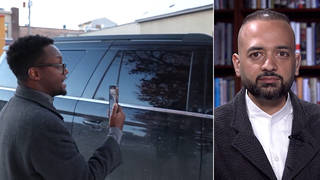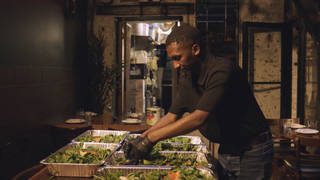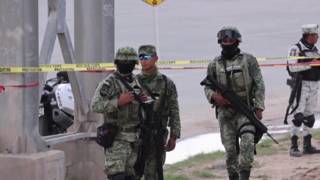
Topics
Guests
- Jan-Albert HootsenDutch journalist and Mexico correspondent at the Committee to Protect Journalists.
Three journalists were killed within a three-day span this week in Mexico, bringing the toll to 11 so far this year and making Mexico the deadliest country in the world for journalists, behind Ukraine. Most of the murders have gone unsolved. This week journalists across Mexico took to the streets protesting the murder of their colleagues and called for accountability. “A crime against a reporter is a crime against the entire country,” says Jan-Albert Hootsen, Mexico correspondent at the Committee to Protect Journalists, who calls the numbers staggering and unprecedented.
Transcript
AMY GOODMAN: Vivir Quintana. The central character of the song is Mexican journalist Miguel Ángel López Velasco, who was murdered in 2011 along with his wife and son in Veracruz, Mexico.
AMY GOODMAN: This is Democracy Now!, democracynow.org, The War and Peace Report. I’m Amy Goodman, as we stay in Mexico right now, where three journalists have been killed this week, bringing the toll to 11 so far this year, making Mexico the deadliest country in the world for journalists, behind Ukraine.
In the eastern state of Veracruz, Yesenia Mollinedo Falconi and Sheila Johana García Olivera were fatally shot by two men on board a motorcycle outside a convenience store this past Monday. Forty-five-year-old Falconi was the director of the online news site El Veraz. Olivera, who was 24, was a reporter at the same outlet. Over the past year, Falconi had publicly spoken about receiving frequent death threats over her work over the past year and a half.
News of their deaths came as journalists across Mexico took to the streets protesting the murder of yet another reporter, this in the northern state of Sinaloa, Luis Enrique Ramírez, a columnist at the newspaper El Debate covering local and state politics, among other issues. The 59-year-old was found killed last Thursday near a dirt road in the city of Culiacán, wrapped in black plastic and with severe head wounds. This week, journalists gathered in outrage in Mexico City.
RODOLFO MONTES: [translated] The wave of murders against the journalistic profession has become uncontrollable. Today, just as we are protesting here in Mexico City, in Tijuana and in Sinaloa, we learned the sad news that two of our colleagues were taken from their lives in Veracruz. It is carnage against journalists in our country. There are no guarantees. The Mexican state is not providing the guarantees so that we can freely exercise our journalistic exercise in Mexican territory.
AMY GOODMAN: And this is Mexican President Andrés Manuel López Obrador responding to the three most recent killings during a news conference this week.
PRESIDENT ANDRÉS MANUEL LÓPEZ OBRADOR: [translated] An investigation is already underway. We will soon have a report. What happened is, of course, unfortunate, and we send an embrace to the family members of the victims.
AMY GOODMAN: AMLO’s response comes amidst intense criticism that he’s allowed reporters to be murdered with impunity during his six years in office and attacked critical journalists as mercenaries who want to undermine his administration. A total of 11 journalists have already been killed in Mexico so far this year. The other eight are Armando Linares López, José Luis Gamboa, Margarito Martínez, Lourdes Maldonado, Roberto Toledo, Heber Fernando López, Jorge Camero and Juan Carlos Muñiz.
For more, we’re joined in Mexico City by Jan-Albert Hootsen, Dutch journalist and Mexico correspondent at the Committee to Protect Journalists.
Jan-Albert, welcome back to Democracy Now! Can you talk about this spate of killings in the last week, three journalists — two at one organization, one in another state — who they are?
JAN-ALBERT HOOTSEN: Thanks for being — thanks for having me.
Yeah, these were journalists who mostly worked for smaller regional outlets — for example, Margarito Martínez, a photographer in Tijuana; Lourdes Maldonado had an online talk show; Armando Linares y Roberto Toledo, who worked for a local news show, local news website in Michoacán called Monitor Michoacán. So, mostly what they have in common is that they work for smaller outlets, they work in smaller community, and, as such, are extremely visible, very highly visible, and easy to trace down, which probably added to the risks that they were running as reporters.
AMY GOODMAN: You have met with some of the family members. Can you tell us what they have said? Also, some of these reporters who were murdered actually raised their concerns, having gotten death threats before, all the way up to AMLO, the president of Mexico.
JAN-ALBERT HOOTSEN: Yes, that’s right. Specifically Lourdes Maldonado, a reporter from Tijuana who was murdered earlier this year, traveled to Mexico City last year and actually told President López Obrador that she felt threatened, that she felt that her life was at risk, and she had actually applied for protective measures from the Baja California state government. Other reporters, such as Armando Linares, who also murdered, warned about the risks that he was running as a reporter just weeks before his collaborator, Roberto Toledo, and about two months before he himself was killed. So these are reporters who are usually very aware of the fact that they are running risks, that they may face reprisals for their reporting, which is usually about organized crime or corruption or abuse by the authorities.
And as you mentioned, yesterday I spoke with the brother of Yesenia Mollinedo, the reporter who was killed in Veracruz, and he told us that his family feels extremely exposed, that they have been in touch with federal and state authorities, but that they feel that the response by the authorities has been woefully insufficient and that they still feel that their life is at risk. Should be noted that Ramiro Mollinedo, the brother of Yesenia, is a reporter himself and that he also focuses on organized crime and corruption and abuse by authorities in the region where he’s working, so that he, like the other reporters who were killed, is very keenly aware that he’s running extreme risks.
AMY GOODMAN: Jan-Albert, can you tell us more about Yesenia and Sheila and their news organization, El Veraz, as well as Luis Enrique Ramírez? I mean, this is just astounding. There is a lot of attention being paid to the journalists in Ukraine, but, I mean, we’re talking about three in the last week, three reporters, and that brings to 11 just this year, and we’re only in May.
JAN-ALBERT HOOTSEN: The numbers are staggering, aren’t they? I think we’re dealing with what might be the deadliest year in modern Mexican history for the press, comparable to, for example, 2017, when a number of reporters were killed in February and March.
And specifically the three latest cases, I know that Yesenia and Johana, her collaborator, worked for a small local news website in the southern part of the state of Veracruz called El Veraz. The site was founded about seven years ago and focused mostly on local politics and the goings-on in the Cosoleacaque area in Veracruz. And Yesenia also covered organized crime in the past. Her brother told me that she stopped covering organized crime several months ago, after she had received numerous death threats. She had reported those several years ago but also by the end of last year. And of Johana, we don’t know all that much. We know that she started working with Yesenia a few months ago, she already had press credentials, and that she was supposedly hired as a camera operator.
Luis Enrique Ramírez, on the other hand, was a reporter who worked for a local news website that he himself had co-founded called Fuentes Fidedignas, where he focused mostly on local politics. But he was more widely known in Sinaloa as a gifted, talented political columnist for El Debate, which is one of the bigger newspapers in Sinaloa. And Luis Enrique Ramírez was actually more widely known amongst journalists in the country as being a protégé of several very well-known writers and journalists, such as Carlos Monsiváis and Elena Poniatowska. He was a very critical, independent mind and very well liked by his readers and by his colleagues.
AMY GOODMAN: Now, Jan-Albert, you’re traveling to Sinaloa today — is that right? — because it’s the fifth anniversary —
JAN-ALBERT HOOTSEN: Yeah.
AMY GOODMAN: — of the murder of Javier Valdez of La Jornada. Talk about the significance of that, and right through to now, five years later, another journalist killed.
JAN-ALBERT HOOTSEN: So, Javier Valdez Cárdenas was one of the most well-known journalists in Mexico, especially of those working outside the Mexico City metropolitan area. And when he was killed five years ago, it came as a shock for a lot of people, myself included, not only because he was the recipient of the CPJ International Press Freedom Award, an award that we give out each year, but also because he was a personal friend of mine. I knew him fairly well for about 10 years before he was killed. And I think the consequences of his death are still echoing into the here and now, because when such a high-profile journalist as Javier Valdez was killed — he was very likely killed because of his writing about organized crime in Sinaloa — then it means that very few journalists are actually not at risk here in Mexico.
AMY GOODMAN: Jan-Albert, I wanted to go for a minute to Javier Valdez speaking at that awards ceremony you were just talking about, the International Press Freedom Awards, when he got it from your organization, the Committee to Protect Journalists, in 2011.
JAVIER VALDEZ CÁRDENAS: [translated] I have been a journalist these past 21 years, and never before have I suffered or enjoyed it this intensely, nor with so many dangers. In Culiacán, in the state of Sinaloa, Mexico, it is dangerous to be alive. And to do journalism is to tread an invisible line drawn by the bad guys, who are in drug trafficking and in the government, in a field strewn with explosives. …
This is a war, yes, but one for control by the narcos. But we, the citizens, are providing the deaths, and the Mexican and U.S. governments, the guns. And they, the eminent, invisible and hidden ones, within and outside of the governments, they take the profits.
AMY GOODMAN: So, that was Javier Valdez speaking in 2011 when he was receiving his International Press Freedom Award. Jan-Albert Hootsen, as we wrap up, many journalists are very critical of the Mexican president, Andrés Manuel López Obrador, for not doing more. What can be done? What are the demands being made right now?
JAN-ALBERT HOOTSEN: I think it’s not an easy question to answer, what can be done, because the problem is so widespread and so deeply ingrained in Mexican society. But I think the best way the Mexican government could go about this, in answering your question about what are the demands, is, first and foremost, he should invest far more heavily in law enforcement, in prosecutors and police, and best practices in specifically addressing the components that are very particular to the murders of journalists. He should also improve the security of journalists by strengthening institutions that have been created to protect reporters and human rights defenders. And something that specifically President López Obrador really has to do, he has to stop polarizing, antagonizing journalists and creating this divide between Mexican citizens and reporters, because right now his polarizing attitude towards the press makes it a lot harder for us to convey the urgency of the problem that a crime against a reporter is a crime against the entire country.
AMY GOODMAN: Jan-Albert Hootsen, I want to thank you for being with us, Dutch journalist and Mexico correspondent at the Committee to Protect Journalists, speaking to us from Mexico.
Next up, Russia is threatening to take retaliatory steps after Finland’s leaders announced plans to join NATO. Stay with us.
[break]
AMY GOODMAN: “Police State” by Pussy Riot. One of the band’s members, Maria Alyokhina, escaped from Russia to Lithuania this week. She was disguised as a food delivery person, evading police staking out the apartment where she was staying. The band is now going on tour in support and solidarity with the people of Ukraine.












Media Options